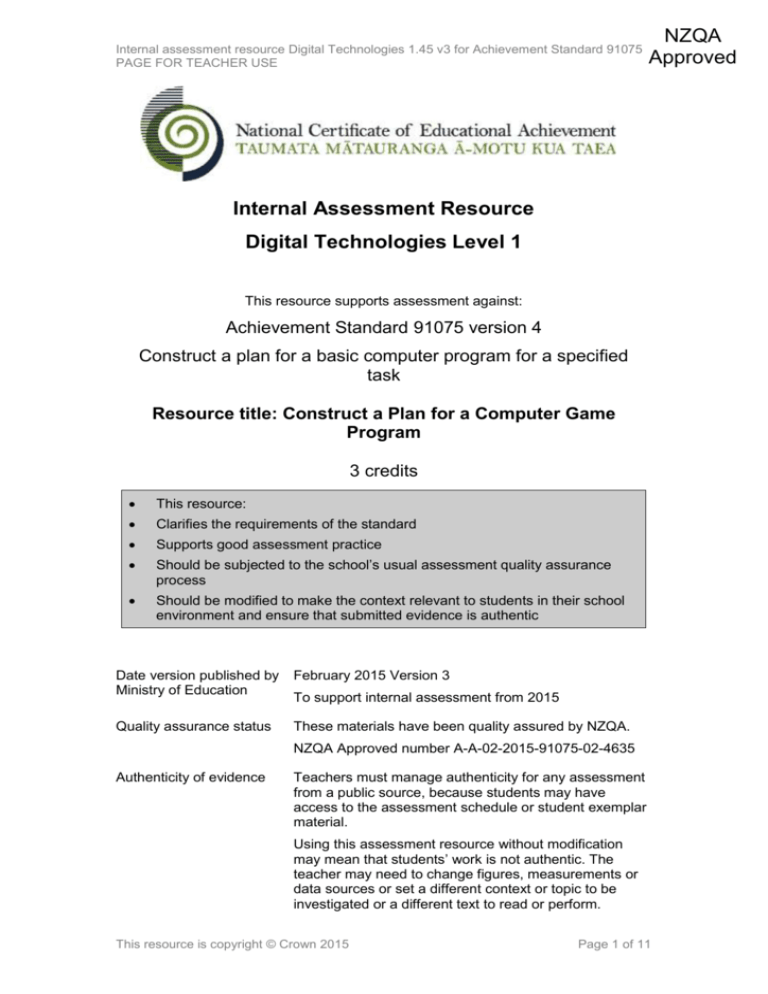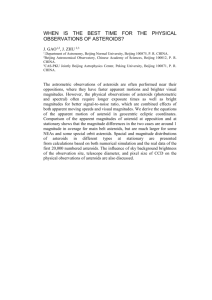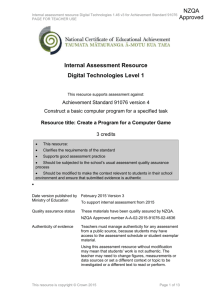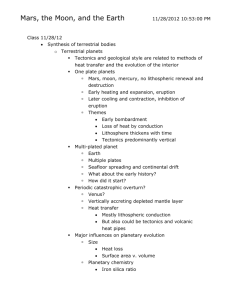1.45 v3 (Word, 152 KB)
advertisement

Internal assessment resource Digital Technologies 1.45 v3 for Achievement Standard 91075 PAGE FOR TEACHER USE NZQA Approved Internal Assessment Resource Digital Technologies Level 1 This resource supports assessment against: Achievement Standard 91075 version 4 Construct a plan for a basic computer program for a specified task Resource title: Construct a Plan for a Computer Game Program 3 credits This resource: Clarifies the requirements of the standard Supports good assessment practice Should be subjected to the school’s usual assessment quality assurance process Should be modified to make the context relevant to students in their school environment and ensure that submitted evidence is authentic Date version published by Ministry of Education February 2015 Version 3 Quality assurance status These materials have been quality assured by NZQA. To support internal assessment from 2015 NZQA Approved number A-A-02-2015-91075-02-4635 Authenticity of evidence Teachers must manage authenticity for any assessment from a public source, because students may have access to the assessment schedule or student exemplar material. Using this assessment resource without modification may mean that students’ work is not authentic. The teacher may need to change figures, measurements or data sources or set a different context or topic to be investigated or a different text to read or perform. This resource is copyright © Crown 2015 Page 1 of 11 Internal assessment resource Digital Technologies 1.45 v3 for Achievement Standard 91075 PAGE FOR TEACHER USE Internal Assessment Resource Achievement Standard Digital Technologies 91075: Construct a plan for a basic computer program for a specified task Resource reference: Digital Technologies 1.45 v3 Resource title: Construct a Plan for a Computer Game Program Credits: 3 Teacher guidelines The following guidelines are supplied to enable teachers to carry out valid and consistent assessment using this internal assessment resource. Teachers need to be very familiar with the outcome being assessed by Achievement Standard Digital Technologies 91075. The achievement criteria and the explanatory notes contain information, definitions, and requirements that are crucial when interpreting the standard and assessing students against it. Context/setting Two approaches are possible when using this standard for assessment. The students produce a plan for a computer game program, following a common set of specifications for the programming task. The teacher may create the specifications for the programming task in discussion with the class and/or may allow individual students to negotiate a variation of the specifications as long as it allows the students to meet the requirements of the standard. See student instructions for sample specifications. These should be totally reworked to suit your particular context and selected outcome. The students have been engaged in technological practice and are at the point where they have fully established the specifications for their computer program and are ready to construct the plan for the computer program. This activity uses the first approach and requires the student to construct a plan for a computer game program that would perform certain specified functions for a computer game. This activity could be used in conjunction with a companion activity, 1.46 Create a program for a computer game, which is designed to assess students against Achievement Standard 91076. See explanatory note 3 in the standard for a definition of a plan. Prior learning Before being given this task, ensure that your students have had ample opportunity to practise constructing a plan for a basic computer program. They need to know how to plan the program using relevant tools such as a flow charts, pseudocode or diagrams. They also need to know how to specify in their plan how the following will be implemented in their program: variables with at least two different types of information and assignment This resource is copyright © Crown 2015 Page 2 of 11 Internal assessment resource Digital Technologies 1.45 v3 for Achievement Standard 91075 PAGE FOR TEACHER USE sequence, selection and iteration control structures predefined actions (e.g. predefined methods, functions, or procedures) input from a user, sensors, or other external source a comprehensive set of test cases with expected, boundary and invalid input for testing the program. Note: Expected, boundary and invalid inputs for testing the program would typically cover numeric inputs (e.g. 9, 0, -10) and/or game related behaviours (e.g. response to multiple key presses, or game object going out of bounds). Students should also be shown what makes an effective procedural structure with well-chosen actions, conditions and control structures. Conditions The teacher will specify the manner in which the students plan the program. This could be natural language (as long as it is unambiguous and precise), diagrams (including screen layouts), and pseudocode. This is an individual assessment activity. It is recommended that students be given 6 weeks of in-class time to learn the skills and complete assessment. Resource Requirements Digital planning tools could be Inspiration/Webspiration (http://www.inspiration.com/WebspirationClassroom), Pencil (http://pencil.evolus.vn/en-US/Home.aspx), iPlotz (http://iplotz.com/), Microsoft Office/Visio, Adobe Photoshop etc. Introduction to Gamemaker Lite Carol Green available from Natcol Publishing. Additional Information This standard requires you to make judgements about the ways in which the student has constructed their plan, as well as about the quality of the finished plan. For example, you are required to judge (for Merit) whether the student has shown “independence and accuracy (well-chosen)” in the construction of their plan. Independence relates to the student’s manner of working. Specifically, do they get on and make their plan with minimal advice and guidance from their teacher and without relying on help from fellow students? Some evidence will come from classroom observation and from conferencing with the student. You must be able to justify such judgements with evidence, e.g. notes that you have made. Accuracy (well-chosen) can be measured within the plan, e.g. the student has specified actions, conditions and control structures that cater for expected and boundary test cases for their computer game and there are no obvious faults with their choices. The criterion for Excellence relates to the efficiency (refer to explanatory note 8 and 9 in the standard) of the constructed plan for a basic computer program. All of the evidence for efficiency can be found within the plan. The plan is hard to improve on and correctly handles a comprehensive set of test cases. Independence Ensure that all students know what “construct with independence” looks like. This resource is copyright © Crown 2015 Page 3 of 11 Internal assessment resource Digital Technologies 1.45 v3 for Achievement Standard 91075 PAGE FOR TEACHER USE Achieved – construct (with some guidance) “With some guidance” means the teacher (or peers) may: respond to student-initiated requests for assistance, for example, where to find suitable resources, what tool to use sometimes prompt the student to, for example, consider other options, think about the wisdom of a choice, reread the brief. The teacher (or peers) may NOT, however: make any decisions for students assist a student in any hands-on way (do any part of the project for them) respond to frequent questions or requests for step-by-step guidance. Merit – construct “with independence and accuracy” “With independence” means the student: owns the planning (takes responsibility for achieving a quality plan) is well-organised, self-starting, self-managing does their own decision-making books any equipment/machines they need in timely fashion manages their files carefully so that they are easily retrieved at the start of the next period carries out appropriate checking and testing and takes corrective action as necessary recognises and deals with issues promptly instead of allowing them to blow the timeline is always able to describe what they are doing, why, and where their planning is up to. It does NOT mean that the student: is unable to ask for help with technical or software issues (for example, faulty equipment) Excellence — construct “with independence and accuracy” There is no step-up on “independence and accuracy” for Excellence – see Merit. This resource is copyright © Crown 2015 Page 4 of 11 Internal assessment resource Digital Technologies 1.45 v3 for Achievement Standard 91075 PAGE FOR STUDENT USE Internal Assessment Resource Achievement Standard Digital Technologies 91075: Construct a plan for a basic computer program for a specified task Resource reference: Digital Technologies 1.45 v3 Resource title: Construct a Plan for a Computer Game Program Credits: 3 Achievement Construct a plan for a basic computer program for a specified task. Achievement with Merit Skilfully construct a plan for a basic computer program for a specified task. Achievement with Excellence Efficiently construct a plan for a basic computer program for a specified task. Student instructions Introduction This assessment task requires you to construct a plan for a computer game program. This task gives specific examples for an Asteroid game. However, you may have developed your game idea as part of technological practice or your teacher may have specified a different game idea. Your teacher will specify the manner in which you construct your computer game program. You will be assessed on how skilfully you construct a plan for the program (this includes your independence shown in constructing the plan) and the efficiency of the plan. The criterion for Excellence relates to the efficiency of the constructed plan for a basic computer program. All of the evidence for efficiency can be found within the plan e.g. constructing a flexible and robust plan, specifying an effective procedural structure that constitutes a well-structured logical solution to the task, specifying a comprehensive set of test cases with expected, boundary and invalid input. See resources for further clarification of these terms. This is an individual assessment activity. You will have 6 weeks of in-class and outof-class time for teaching, learning and assessment. Teacher note: Adapt the time allowed and the format of the assessment to meet the needs of your students. Task Teacher note: Below is a set of generic requirements for a basic computer game program. There is also an interpretation of these into a specific Asteroid computer game. You should rework these requirements to suit your particular context or game idea. Construct a plan for a basic computer game program which includes: a variety of variables (e.g. score, health, lives, can_move) storing at least two types of information (e.g. number, Boolean) assignment of variables (e.g. set the score to 0) This resource is copyright © Crown 2015 Page 5 of 11 Internal assessment resource Digital Technologies 1.45 v3 for Achievement Standard 91075 PAGE FOR STUDENT USE predefined actions (e.g. move free, move stk.s, switch to costume, change sprite) user input (e.g. Keyboard Left, Space) sequence Control Structure (e.g. the order of your programming commands when the start game button is clicked) selection Control Structure (e.g. conditional statements such as if, then, else or when event occurs, wait until, alarms, test variable) iteration Control Structure (e.g. loops such as Repeat or Step Event) accurate and explanatory variable names (e.g. playerName, spr_SpaceShip) comprehensive testing and debugging to identify and fix errors in the program’s functionality (e.g. does the space ship shoot bullets when the space bar is pressed) Example – Asteroids If you are constructing a plan for an Asteroids computer game, your plan must allow for the following: a title screen with playing instructions and a start button a spaceship, bullets and at least two asteroids initialisation of the appearance and starting locations of the spaceship, bullets and asteroids at least two variables (e.g. pilot_name, Score) comprised of multiple data types (e.g. String, Int) player input (e.g. keyboard presses to move the spaceship and fire bullets at the asteroids) collisions between asteroids and bullets, and between asteroids and the spaceship with related effects on score and lives increasing difficulty as the game progresses (e.g. the asteroids move faster, or more asteroids appear) feedback to the player on their performance on a ‘Game Over’ screen a way for Asteroids to continue moving (e.g. wrap around screen, bounce off edge, etc). Your plan should: communicate the structure and function of a computer program be developed in the context of your target programming environment or language be communicated using a range of tools as specified by your teachers should not be expressed in program code The range of tools may include but are not limited to: natural language (as long as it is unambiguous and precise), diagrams (including screen layouts), and pseudocode. In all cases ensure that the plan for your basic computer game program specifies: variables, assignment and their data types procedural structure that combines predefined actions with sequence, selection and iteration control structures input from a user, sensors, or other external source input test cases This resource is copyright © Crown 2015 Page 6 of 11 Internal assessment resource Digital Technologies 1.45 v3 for Achievement Standard 91075 PAGE FOR STUDENT USE Write your plan so that the purpose of each part of the plan is clear. This means describing the purpose or function of actions, conditions and control structures specified within the plan (e.g. This script/function will be called when the game starts and will constantly check to see if the player is touching the edge of the screen. If touching edge is true, then the player wraps around the screen). Use explanatory variable names (e.g. pilot_name) and include the type of variable (e.g. String) and the purpose (e.g. This variable will hold the player’s name so that personalised feedback can be given throughout the game). To achieve with Merit you will need to demonstrate independence when constructing your plan and ensure that you specify a procedural structure that results in a sequence of actions that correctly performs the task and has no unintended behaviour or consequences. To demonstrate an efficient plan, ensure you have an effective procedural structure where each individual control structure has a clear and well defined purpose within the structure of the plan, and which has no unnecessary duplication or repetition (e.g. The plan uses a controller object, so that all variables can be initialised in one script. This means that it is only necessary to change aspects such as initialising the score or number of lives, of the game once). Include in your plan a testing schedule with input cases that ensures that your program will work correctly on all inputs – expected, boundary, and invalid. Hand in your final plan. This resource is copyright © Crown 2015 Page 7 of 11 Internal assessment resource Digital Technologies 1.45 v3 for Achievement Standard 91075 PAGE FOR TEACHER USE Assessment schedule: Digital Technologies 91075 Construct a Plan for a Computer Game Program Evidence/Judgements for Achievement Evidence/Judgements for Achievement with Merit Evidence/Judgements for Achievement with Excellence The student has constructed a plan for a basic computer program for a specified task. The student has, with guidance: The student has skilfully constructed a plan for a basic computer program for a specified task. The student has: The student has efficiently constructed a plan for a basic computer program for a specified task. The student has: specified variables and their data types specified variables and their data types specified variables and their data types The student’s plan for the Asteroids game specifies necessary variables and their data types. For example the plan includes: The student’s plan for the Asteroids game specifies necessary variables and their data types. For example the plan includes: The student’s plan for the Asteroids game specifies necessary variables and their data types. For example the plan includes: – – – – – – – – – – – – – asteroid_speed, integer lives, integer number_of_asteroids, integer pilot_name, string score, integer specified a procedural structure that combines actions, conditions and control structures – score, integer The student’s plan includes a combination of actions, conditions and control structures. For example: To rotate the spaceship to right, the program will check (inside a forever loop) to see if the right arrow is pressed and if true, will turn the spaceship 5 degrees. When an asteroid collides with the spaceship: a) hide the spaceship b) decrease the lives variable by one c) check to see if lives is below 1 and if true end the game When the spacebar is pressed: a) aim the bullet so it is pointing in the same direction as the spaceship b) show the bullet c) move the bullet This resource is copyright © Crown 2015 asteroid_speed, integer lives, integer number_of_asteroids, integer pilot_name, string independently constructed the plan asteroid_speed, integer lives, integer number_of_asteroids, integer pilot_name, string – score, integer independently constructed the plan The student created the plan for their Asteroids game with limited teacher input and made independent decisions regarding the procedural structure, actions, conditions and control structures to be used within the program. The student created the plan for their Asteroids game with limited teacher input and made independent decisions regarding the procedural structure, actions, conditions and control structures to be used within the program. When making planning decisions, the student referred to previous examples of planning they had completed rather than asking the teacher or peers for assistance. When making planning decisions, the student referred to previous examples of planning they had completed rather than asking the teacher or peers for assistance. specified a procedural structure with wellchosen actions, conditions and control structures The procedural structure specified in the student’s plan demonstrates well-chosen actions, conditions and control structures. For specified a procedural structure with wellchosen actions, conditions and control structures The procedural structure specified in the student’s plan demonstrates well-chosen actions, conditions and control structures. For Page 8 of 11 Internal assessment resource Digital Technologies 1.45 v3 for Achievement Standard 91075 PAGE FOR TEACHER USE 5 steps and repeat it in a loop 20 times so the bullet appears to shoot rather than jump. To keep the asteroid moving when it hits the edge of the screen, the built-in Scratch motion function, “If on edge, bounce” will be used. specified a set of test cases with expected inputs for testing the program. The student’s plan identifies a set of test cases that the student will check to ensure that the game works correctly on expected inputs. For example: – I will check to see that when the space bar is pressed a bullet fires from the spaceship – I will check to see that when the left arrow key is pressed it rotates the ship to the left. This description relates to only part of what is required, and is indicative only. example: example: – To ensure that there won’t be an immediate collision at the start of the game, the student has planned to set the starting co-ordinates of the spaceship to centre of the screen and the starting co-ordinates of the asteroids at random positions around the edges of the screen. – To keep the asteroids moving, the student has planned a wrap detection script which checks to see if an asteroid is touching the edge inside a repeat loop. The script will then check to see if its X position is greater than or less than the width of the stage or if the Y position is greater than or less than the height of the stage. If one of the conditions is true, the x or y position will be inversed to simulate a wrapping movement. – When the game is over, the player will receive feedback regarding their score and the number of waves they completed. The student has planned to use the join function to join variables together with a duration of 3 seconds, so that the player feedback is displayed more naturally and the player has enough time to read their score. – To ensure that there won’t be an immediate collision at the start of the game, the student has planned to set the starting co-ordinates of the spaceship to centre of the screen and the starting co-ordinates of the asteroids at random positions around the edges of the screen. – To keep the asteroids moving, the student has planned a wrap detection script which checks to see if an asteroid is touching the edge inside a repeat loop. The script will then check to see if its X position is greater than or less than the width of the stage or if the Y position is greater than or less than the height of the stage. If one of the conditions is true, the x or y position will be inversed to simulate a wrapping movement. – When the game is over, the player will receive feedback regarding their score and the number of waves they completed. The student has planned to use the join function to join variables together with a duration of 3 seconds, so that the player feedback is displayed more naturally and the player has enough time to read their score. specified a set of test cases with expected and boundary inputs for testing the program. The student has planned to test expected inputs as well as boundary cases. For example, the student plans to test: – that when the space bar is pressed a bullet fires from the spaceship – that when the left arrow key is pressed it rotates the ship to the left This resource is copyright © Crown 2015 constructed a flexible and robust plan The student has planned ways to make the Asteroids program more flexible and robust. For example: – The plan specifies that there will be two buttons for a player to select the difficulty (Easy or Hard), instead of starting all players at the same level. When the button is clicked a script to initialise the variables that pertain Page 9 of 11 Internal assessment resource Digital Technologies 1.45 v3 for Achievement Standard 91075 PAGE FOR TEACHER USE – that the game functions as expected when the number of lives equals 0 and lives are not allowed to reach a negative number. This description relates to only part of what is required, and is indicative only. to difficulty will be run. – The student has planned to use a controller object, so that all variables can be initialised in one script and in one location. Correct handling of expected, boundary and invalid inputs, or checking input data for validity. This means the program is more efficient to maintain and debug. specified an effective procedural structure that constitutes a well-structured logical solution to the task The student has planned a procedural structure for the Asteroids game that uses control structures with a well-defined purpose and contains no unnecessary duplication or repetition. For example: – The student has planned to use a Boolean variable “canMove” which determines the player’s state (in play or crashed into and thus out of play). The plan calls for one script to control all elements of the program which are dependent upon checking the boolean variable "canMove". Thus, “canMove” is only checked only one time every step. (The plan is for a more efficient program because the program doesn’t have to check the same variable in three different scripts.) – The student has planned to check for a collision between the spaceship and all the asteroids using an OR expression and perform the necessary actions upon collision, instead of using nested if statements for each individual asteroid with resulting redundant code to perform the This resource is copyright © Crown 2015 Page 10 of 11 Internal assessment resource Digital Technologies 1.45 v3 for Achievement Standard 91075 PAGE FOR TEACHER USE necessary actions upon collision. specified a comprehensive set of test cases with expected, boundary and invalid input for testing the program The student has created a testing plan to test the program incrementally throughout the development of the Asteroids game program (e.g. the student plans to test each main script before proceeding to the next stage of development) and have players test the Asteroids game throughout the development of the program (not just at the end). The student’s plan specifies tests for expected inputs as well as boundary cases and invalid inputs. For example, the student plans to test: – that when the space bar is pressed a bullet fires from the spaceship, or when the left arrow key is pressed it rotates the ship to the left. – that the game functions as expected when the number of lives equals 0 and lives are not allowed to reach a negative number. – that when the escape key and up arrow are pressed at the same time, the game functions as intended and ignores the invalid escape key. This description relates to only part of what is required, and is indicative only. Final grades will be decided using professional judgement based on a holistic examination of the evidence provided against the criteria in the Achievement Standard. This resource is copyright © Crown 2015 Page 11 of 11










